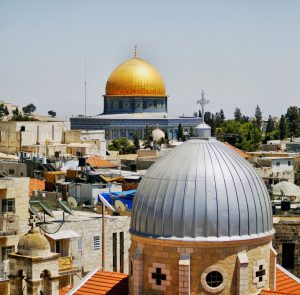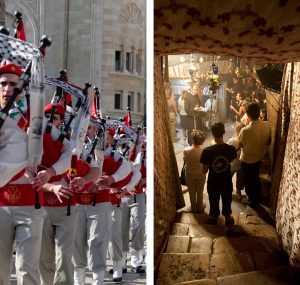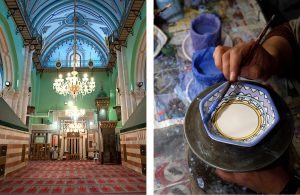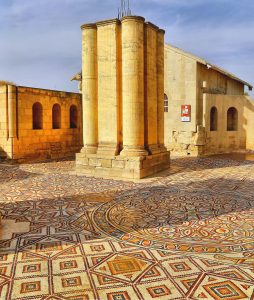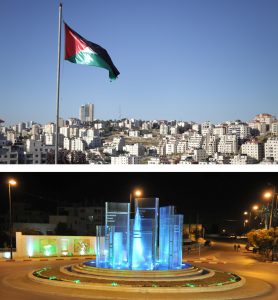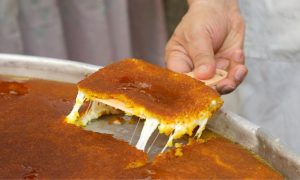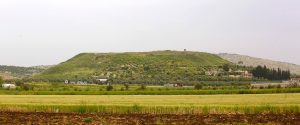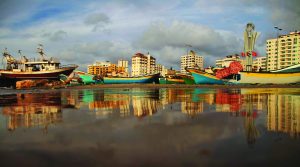With a history that envelops more than one million years, Palestine has played an important role in human civilization. The crucible of prehistoric cultures, it is where settled society, the alphabet, religion, and literature developed, and would become a meeting place for diverse cultures and ideas that shaped the world we know today. Its rich and diverse past, abundant cultural heritage, and the archaeological and religious sites of the three monotheistic faiths, including the birthplace of Jesus Christ, make Palestine a unique center of world history.
Visitors to Palestine will encounter on their journey myriad religious, historical, and archaeological sites. Beyond the historical, Palestine offers walks and hikes in its extensive valleys, along coasts and desert hills, in towns, and ancient marketplaces, at the center of cities and villages nestled in the heart of breathtaking landscapes. They will enjoy Palestine’s sumptuous cuisine and, most important, feel the warmth and hospitality of the Palestinian people, Christians and Muslims alike, who will share with them the hopes and aspirations of a nation that is in the process of rebuilding. With its million years of human history and a welcoming people offering rich hospitality, visitors are left with the warm feeling of being at home.
Jerusalem (Al-Quds)
Jerusalem, as a holy city for Islam, Christianity, and Judaism, is one of the oldest continuously inhabited cities in the world. Archaeological excavations show that the history of the city began over 5,000 years ago. Among its 220 historic monuments are the Dome of the Rock and Al-Aqsa Mosque, which represents the third holiest shrine for Muslims, after the Kaaba in Mecca and the Prophet’s Mosque in Medina, Saudi Arabia. They were built in the seventh century and stand as magnificent pieces of architecture. Jerusalem has always been significant to Christians because it houses many holy places associated with the life, ministry, and teachings of Jesus Christ, and most important, with his crucifixion, burial, and resurrection. Among these sites are the Church of the Holy Sepulcher, which houses Christ’s tomb; the Garden Tomb; the Via Dolorosa; the Mount of Olives; the Garden of Gethsemane; the Kidron Valley; the Tomb of the Virgin Mary; and other holy sites.
The Old City of Jerusalem and its walls is one of the best-preserved medieval Islamic cities in the world. It is divided into four main quarters: the Muslim Quarter, the Christian Quarter, the Armenian Quarter, and the Jewish Quarter. The Old City has been home to many diverse cultures, which are reflected in the architecture and planning of the city and its sacred buildings, streets, markets, and residential quarters. Today, Jerusalem’s living traditions continue, making the city the heart of human history. In 1981, Old City of Jerusalem and its walls were inscribed on the list of the cities of World Heritage in Danger by the Hashemite Kingdom of Jordan.
Bethlehem
The city of Bethlehem is holy to both Christians and Muslims. It is acknowledged as the birthplace of Jesus Christ. The Church of the Nativity, a Byzantine basilica, was built by Helena (the mother of Emperor Constantine), to commemorate Jesus’ birth. It is built on top of a cave where, according to a tradition first documented in the second century AD, Jesus was born. It was first dedicated in 339 AD.
The church is the central feature of Bethlehem and is surrounded by other important sites related to Christ’s birth. Among these is the Milk Grotto, an irregular cave hewn in the soft limestone, located southeast of the basilica, where according to Christian traditions, Mother Mary nursed baby Jesus while hiding there from Herod’s soldiers. The shepherds’ fields, where the angel of the Lord is believed to have appeared before the shepherds to bring them the good tidings of the birth of Jesus, are roughly two kilometers east of Bethlehem. Bethlehem’s old town is the place where a wide range of religious and traditional activities take place. The Patriarch’s Route, which runs along Star Street, is the route of an annual religious procession that takes place during Christmas celebrations. Nativity Square hosts a grand celebration each year, marking the anniversary of the birth of Christ.
In 2012, the Church of the Nativity and the Pilgrimage Route were inscribed on the World Heritage List. In 2014, the Cultural Landscape of Battir Village was also inscribed on the World Heritage List as a pilot site of Palestine, Land of Olives and Vines.
Hebron (Khalil ar-Rahman)
Hebron is one of the oldest continuously inhabited towns in the world. Its Arabic name, Khalil ar-Rahman, means “Friend of God.” Ancient Hebron was situated on Jebel ar-Rumeideh (Rumeideh hill), located southwest of the current historic town.
The city has always been known as the burial place of the prophets Ibrahim/Abraham, Isaac, Jacob, and their wives. During the Roman period, Herod the Great (73–74 BC) built a massive wall to enclose the cave of the prophets’ tombs. After the conquest of Hebron by the Crusaders (1099), this enclosure was turned into a church, and subsequently, after Saladin’s retaking of the city in 1187, became a mosque.
With the Arab-Muslim conquest, Hebron became the fourth sacred city of Islam after Mecca, Medina, and Jerusalem, and was visited by Muslim pilgrims from all over the world. The town and the mosque were honored and sanctified by the rulers of successive Muslim states, the Islamic leaders, and by the public. The city flourished during Mamluk rule (1250–1516 AD), and during Ottoman rule (1517–1918), the town witnessed a period of expansion, giving the old city its present-day shape and boundaries. Still dominated by Mamluk-style architecture, the old town of Hebron is one of the few Islamic cities that has preserved its authentic setup, visible in its urban fabric and prestigious architecture, corroborated by its particular craftsmanship. Its market, (souq) has striking arched roofs and a maze of alleys that are definitely worth exploring. The shops and stalls sell everything from pottery, olivewood, and blown glass to a wide array of aromatic spices and dried fruits.
In 2017, UNESCO declared the old city of Hebron a Palestinian World Heritage Site of unique and extraordinary value.
Jericho
Located 36 kilometers east of Jerusalem, Jericho is on the road to Amman and at the junction of the highway to the Galilee. Tell as-Sultan, the ancient city of Jericho, is the lowest (258 meters below sea level) and the oldest town on earth, dating back more than 10,000 years. It grew up around a perennial spring, Ain as-Sultan, in an area of fertile alluvial soil that attracted hunter-gatherer groups to settle and start the process of plant and animal domestication. Ain as-Sultan is known as Elisha’s Spring, where the prophet Elisha cleansed the water of Jericho.
Jericho’s moderate climate makes it a favorite winter resort, as it is always a number of degrees warmer than other parts of Palestine, owing to its low elevation and the height of the surrounding mountains. It is an important agricultural area, producing fresh fruits and vegetables year-round. Jericho dates, bananas, and citrus fruits are especially famous.
Among the main touristic and archaeological sites in Jericho are the Monastery of Temptation (Deir Quruntel), the Umayyad Hisham’s Palace, the Sycamore tree and Russian museum, Qumran, Wadi Qelt and the Monastery of Saint George, Maqam an-Nabi Musa, the Jordan River, and the Dead Sea.
Ramallah
Located 16 kilometers north of Jerusalem, at an elevation of 900 meters above sea level at the crest of the hills, Ramallah is known as the “Bride of Palestine” because of its general geographical beauty. Ramallah has a pleasant, cool climate and has long been a popular summer resort. During the twelfth century, French Crusaders built a stronghold in Ramallah, and the remains of a Crusader tower, known as At-Tira, can still be seen in the old part of town.
With its lively town center, museums, art galleries, theaters, parks, booming restaurant scene, and bustling nightlife, modern Ramallah is a fast-growing cosmopolitan town. It is also very welcoming towards visitors, with comfortable places to stay, some of Palestine’s best restaurants, good transport, other tourism-related services, and hospitable, friendly people.
Ramallah’s twin city, Al-Bireh, is located on the central ridge running through the mountains of central Palestine. Its location served as a cross-border trade route
between the north and south, along the caravan route between Jerusalem and Nablus.
The city of Ramallah is surrounded by several major historical, cultural, and natural sites, such as Beitin, Taybeh, Abud, Tell an-Nasbah, Birzeit, Jifna, and Ein Kenya Nature Reserve.
Nablus
Neapolis, the new city, was founded by the Roman Emperor Vespasian in 72 AD. It was built on the northern slope of Mount Gerizim; around two kilometers west of Tel Balata (the Canaanite town of Shechem). Mount Gerizim, or Jebel at-Tor, is the sacred mountain of the Samaritans, now a small Palestinian community of only a few hundred people.
Over the years, the original Greek name, Neapolis, was Arabicised into the city’s modern name, Nablus. The city developed into a major center in the second century AD. Major building projects were launched, including the hippodrome, the theater, and other public buildings. During the Roman period, a temple dedicated to Zeus was erected on Mount Gerizim, and the city was raised to the status of a Roman colony. Neapolis flourished during the Byzantine and the Islamic Arab periods. From the tenth century, it was known as little Damascus.
The seven quarters of the old city represent a distinctive example of traditional urban architecture in Palestine. The city center features a bustling market, or souq, with impressive mosques, Turkish baths, and traditional soap factories. At the end of the eighteenth century, the city began to expand outside its original walls.
Today, Nablus is considered the major commercial, industrial, and agricultural center in the northern region of Palestine. It is known for its olive oil soap, talented goldsmiths, and traditional sweets. Nablus is considered to be the best place in Palestine to eat knafeh, a beloved Palestinian dessert made from cheese and semolina flour, and dripping with sweet rosewater syrup.
Touring the old city of Nablus is highly recommended to admire the unique architecture, and later to visit Jacob’s Well at the Greek Orthodox Monastery, in addition to visiting Sebastia, located 12 kilometers northwest of Nablus, one of the oldest continuously inhabited places in Palestine, which flourished during the Roman and Byzantine periods. The present town of Sebastia, including the archaeological remains, the historical town, and the cultural landscape, is a major tourist attraction, represented by the shrine of Nabi Yahyia, the Cathedral of John the Baptist, the Roman mausoleum, the olive press, Kayed Palace, and the traditional buildings, along with a hiking trail.
Jenin
Jenin is located about 43 kilometers north of Nablus, on the ancient trade road from Nablus through Wadi Bal’ama and across the plain of Marj Ibn Amer and Lajjun to Haifa , with an altitude of about 100–250 meters above sea level. The name was derived from Ein Ganim meaning the spring of Ganim and referring to the region’s plentiful spring. Jenin, known as Gina in the Amarna letters in the fourteenth century BC, and Gina in the Roman period, the city was named Grand Grin during the Crusader period.
Today, Jenin is a picturesque town built on the slopes of a hill and surrounded with gardens of carob, fig, and palm trees. It is distinguished by its agriculture, producing an abundance of fruits and vegetables. The main attractions in Jenin and the surrounding area are Khirbet Bal’ama and its water tunnel, the Church of the Ten Lepers at Burqin, Tell Taannek, Tell Dothan, Arraba and the Abdulhadi Palaces, Sanur Citadel, Zababdeh, Fatima Khatoon Mosque (The Grand Mosque), and the Forest of Umm Al-Rihan.
Tulkarem
The prosperous town of Tulkarem is located 12 kilometers from the Mediterranean Sea, and about 15 kilometres west of Nablus. Its location between the coastal plain and mountains of central Palestine has made it an important stop along both trade and conquest routes over the course of history. Originally inhabited by the Canaanites, its ancient name was Tur Karm, meaning the Mountain of Vineyards, because of its fertile land.
During the Ayyubid period and later the Mamluk period (1260–1516), most of Tulkarem’s lands were made part of a waqf (religious trust) to support Al-Madrasa al-Farisiyya in Jerusalem. The mainstay of the Tulkarem economy was agriculture, and fertile land produced grain, citrus, fruits, and olives.
Qalqilya
Situated 12 kilometers from the Mediterranean coast, Qalqilya was once a Canaanite city. Its name was derived from a Roman castle known as Qala’alia. This small town has the only zoo in Palestine, which was established in 1986.
Gaza
The city of Gaza is located on the Mediterranean seashore, 32 kilometers north of the Egyptian border. It is considered one of the most ancient towns in the world. Strategically placed on the Mediterranean coastal route, ancient Gaza was a prosperous trade center and a stop on the caravan route between Egypt and Syria.
Today, Gaza City is the economic center for a region where citrus fruits and other crops are grown. The city is famous for its handwoven carpets, wicker furniture, and pottery. Famous also for its fresh seafood, Gaza has numerous restaurants along the beach as well as public parks where visitors can enjoy the pleasant Mediterranean breeze.
Major historical, archaeological, and touristic attractions in Gaza include Anthedon Port, Tell Um Amer, the Great Mosque, Napoleon’s Fort, St. Porphyrus Church, Al-Zaytun and Al-Daraj Quarters, Sayyed Hashem Mosque, Khan Yunis, Rafah, Deir al-Balah and Wadi Gaza.

